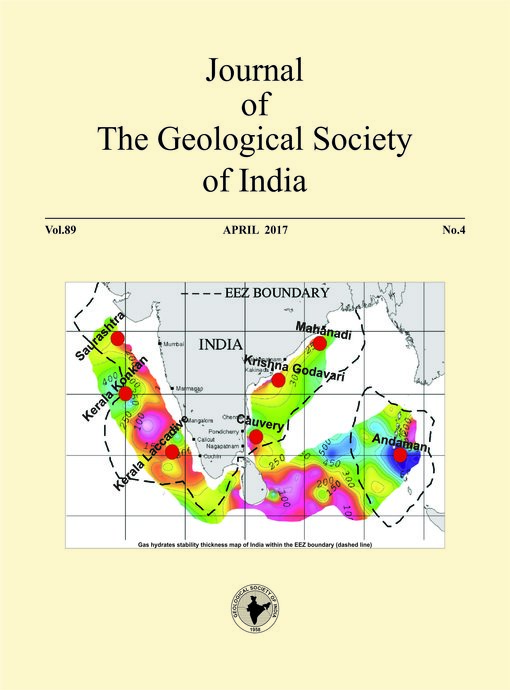A Note on ‘Composite Dike' in Basement Granite in the Vicinity of Srisailam Sub-Basin Near Akkavaram, Telangana
DOI:
https://doi.org/10.1007/s12594-017-0619-6Abstract
A composite dike has been noticed in basement granite in the vicinity of Srisailam sub-basin near village Akkawaram, Mahabubnagar district, Telangana. It is trending N-S and traced over an extent of 600m in eastern flank of Akkavaram outlier and comprises rocks of mafic and felsic composition characterized by both gradational and abrupt contacts. On the basis of petrographic studies, felsic part of dike is designated as bostonite and mafic as dolerite. Geochemically, they are grouped into (i) trachyte to trachydacite and (ii) basalt categories. Such dissimilar mineralogical and chemical characters in a single dike may be due to coexistence of magma of contrasting composition and provides vital information for understanding the two phase liquid. Interestingly, high uranium values (0.022% U3O8) recorded in parts of felsic portion.Downloads
Metrics
Issue
Section
Downloads
Published
How to Cite
References
Carrigan, C.R. and Eeichelberg, J.C. (1990) Zoning of magmas by viscosity conduits. Nature, 343, pp. 248-251.
French, J.E.and Heaman, L.M. (2010) U–Pb dating of Paleoproterozoic mafic dyke swarms of the south Indian Shield: implications for paleocontinental reconstructions and identifying ancient mantle plume events. Precambrian Res., v.183, pp.416–441.
Furman, T. and Spera, F.S. (1985) Comingling of acid and basic magma with the implication for the origin of mafic I-type xenoliths: field and petrochemical relations of an unusual dike complex at Eagle Lake, Sequoia Park, California, USA. Jour. Volcanol. Geothermal Res., v.24, pp.151-178.
Halls, H.C. (1982) The importance of potential of mafic dike swarms in studies of geodynamic processes. Geoscience Canada, v.9(3), pp.145-152.
Jarrar, G., Saffarini, G., Baumann, A. and Wachandrof, H. (2004) Origin, age and petrogenesis of neo-Proterozoic composite dike from Arabian-Nubian Sield, SW Jordan. Geol. Jour., v.35, pp.157-178.
Kanaris Sotiriou, R. and Gibbs, F.G.F. (1985) Hybridization and petrogenesis of composite intrusion: The dike at Cumhann Isle of Arran, Scotland. Geol. Mag., v.122, pp.361-372.
Karunakaran, C. (1971) Ultramafic and related rocks in the southern Peninsular India, Proc. Symposium II. Upper Mantle Project, NGRI, Hyderabad. pp.361-376.
Katzir, Y., Litvinosky, B.A., Jahn, B.A., Eyal, M., Zenvilevich, A.N., Velley, J.M., Vapnic, Ye., Beeri, Y. and Spicuzza, M.J. (2007) Interrelationship between coeval mafic and A-type silicic magma from composite dike in a bimodal suite of south Israel Northernmost Arabian-Nubian Shield: Geochemical and Isotopic constraints. Lithos, v.97(3-4), pp.336-364.
Koyaguchi, T. and Takada, F. (1994) An experimental study of the formation of composite intrusion from zoned magma chamber. Jour. Volcanol. Geothermal Res., v.59, pp.261-265.
Kumar, A., Nagaraju, E., Besse Jean, and Bhaskar Rao, Y.J. (2012) New age, geochemical and paleomagnetic data on a 2.21 Ga dyke swarm from south India: Constraints on Paleoproterozoic reconstruction. Precambrian Res., v.220-221, pp. 123-138.
Le Bas, M.J., Le Maitre, R.W., Streckisen, A. and Zenettin, B. (1986) A chemical classification of volcanic rocks based on total alkali- silica diagram. Jour. Petrology, v.27, pp.745-750.
Litvinosky, B. A., Zanvilevich, A. N. and Kalmanovich, M. A. (1995) Recurrent mixing and mingling of coexisting syenite and basalt magma in Ust'Khilol massif, Transbaikalia and its petrological significance. Petrology, v.3, pp.115-137.
Mallikarjuna Rao, J., Bhattacharji, S., Rao, M. N. and Hermes, O. D. (1995) 40Ar-39Ar ages and geochemical character of dolerite dikes around the Proterozoic Cuddapah Basin, South India. Mem. Geol. Soc. India. no.33, pp.307-328.
Mashall, L. A. and Sparks, R. S. J. (1984) Origin of some mixed magma and net veined ring intrusions. Jour. Geol. Soc. London, v.141, pp.171-182.
Murthy, Y.G.K., Babu Rao, V., Gupta Sharma, D., Rao, J.M., Rao, M.N. and Bhattacharji, S. (1987) Tectonic, petrochemical and geophysical studies of mafic dike swarm around the Proterozoic Cuddapah Basin, South India. In: H.C. Halls and W.F. Fahrig (ed.) Mafic Dike Swarms. Geol. Assoc. Canada, Special Paper no.34, pp.303-316.
Pandey B.K., Gupta J.N., Sarma K.J. and Sastry C.A. (1997) Sm-Nd, Pb-Pb and Rb-Sr geochronology and petrogenesis of the mafic dyke swarm of Mahbubnagar, South India: implications for Paleoproterozoic crustal evolution of the Eastern Dharwar Craton. Precambrian Res., v.84, pp.181-196.
Poli, G.E. and Tommazinii, S. (1991) Model of the origin and significance of microgranular enclave in calc-alkaline granitoid. Jour. Petrol., v.32, pp.65-7666.
Poornachandra Rao, G. V. S. (2005) Orthogonal dikes around the Cuddapah Basin-A Paleomagnetic study. Jour. Indian Geophys. Union, January, v.9(1), pp. 1-11.
Srinivasan, K.N. and Krishnappa, T. (1991) Geology of the Peddavuru and Jonnagiri Schist belts, Andhra Pradesh. Rec. Geol. Surv. India, v.124(5), pp.261-263.
Stern, R.J. and Voegeli, D.F. (1987) Geochemistry, geochronology, and petrogenesis of a Late Precambrian (=590 Ma) composite dike from North Eastern Desert of Egypt. Geol. Rundsch., v.76, pp.325-341.
Synder, D., Crambles, C., Tait, S. and Weibe, R.A. (1997) Magma mingling in dikes and sills. Jour. Geol., v.105, pp. 75-86.
Titov, A.V., Litvinosky B. A., Zenvilevich, A.N. and Shadaev, M. G. (2000) Hybridization in composite basic- rock-leucogranite dike of the Ust'-Khilol massif, Transbaikalia. Russian Geology and Geophysics, v.41, pp.16621675.
Vogel, T. A. and Wilband, J. T. (1978) Coexisting acidic and basic melt: geochemistry of a composite dike. Jour. Geol., v.86, pp.353-371.
Weibe, R. A. and Ulrich, R. (1997) Origin of composite dike in Gouldsboro granite, Coastal Maine. Lithos, v.40, pp.157-178.
Winchester, J.A. and Floyd, P.A. (1977) Geochemical discrimination of different magma series and their differentiation products using immobile elements. Chem. Geol., v.20, pp.325-343

 S. K. Srivastava
S. K. Srivastava






